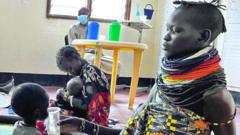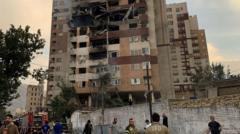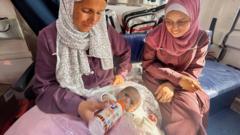As hunger edges closer to disaster in Kakuma, Kenya, severe cuts to U.S. aid are fueling a growing crisis among refugees, primarily affecting vulnerable children who rely on limited food rations and support from humanitarian organizations.
Starvation Crisis Looms as Kenyan Refugees Face Severe Aid Cuts

Starvation Crisis Looms as Kenyan Refugees Face Severe Aid Cuts
Recent U.S. funding reductions lead to drastic food shortages for children in Kakuma refugee camp.
In the sprawling Kakuma refugee camp in northwestern Kenya, the stark realities of starvation confront hundreds of thousands of displaced individuals. A United Nations official recently shared with BBC News that the situation has reached alarming levels, exacerbated by substantial U.S. funding cuts that have drastically reduced food rations, leaving many on the brink of starvation.
Kakuma camp, housing approximately 300,000 refugees fleeing conflict from various African and Middle Eastern nations, is overwhelmed, with malnourished children filling its Amusait Hospital. Inside the facility’s 30-bed ward, physicians work tirelessly to provide care for infants suffering from severe acute malnutrition. One young patient, Hellen, barely stirs, her skin exhibiting troubling signs of malnutrition, while another nine-month-old infant, James, struggles daily to receive adequate food as aid dwindles.
“Food is not enough; my children only eat once a day,” says Agnes Awila, James’s mother, expressing the grim reality many families face. Previously, families depended on the United Nations World Food Programme (WFP) for vital nutrition, but following U.S. President Donald Trump's sweeping aid cuts earlier this year, the WFP has slashed support dramatically. This has left them offering only 30% of the minimum recommended caloric intake necessary for health.
The situation has become dire for many, including 51-year-old Mukuniwa Bililo Mami, a long-time resident of the camp. She recounts days when refugees would access three meals a day. Now, she struggles to make the limited rations last for a month. The cuts extend beyond food, as cash assistance also evaporated; this direct monthly support of around $4 million previously allowed families to obtain critical supplies, leading to further despair.
Local traders like Badaba Ibrahim have felt the repercussions, as cash-strapped refugees can no longer shop, leaving them to beg for food outside stores. Meanwhile, single mother Agnes Livio shares meager portions with her five sons, noting the troubling reality that their first meal now occurs in the afternoon.
The hunger crisis looms larger as medics in the hospital are forced to use tubes to feed several malnourished infants. With few prospects for increased funding and vital assistance drying up, the outlook for the more than 300,000 refugees in Kakuma appears increasingly grim. Felix Okech, head of refugee operations for WFP in Kenya, acknowledges this dire situation, underscoring the reliance on U.S. support, which has historically covered over 70% of their funding.
"Unless there is a significant change, we are looking at starvation scenarios for many in the months ahead,” Mr. Okech warns, highlighting the urgency of the crisis that remains unresolved.
Kakuma camp, housing approximately 300,000 refugees fleeing conflict from various African and Middle Eastern nations, is overwhelmed, with malnourished children filling its Amusait Hospital. Inside the facility’s 30-bed ward, physicians work tirelessly to provide care for infants suffering from severe acute malnutrition. One young patient, Hellen, barely stirs, her skin exhibiting troubling signs of malnutrition, while another nine-month-old infant, James, struggles daily to receive adequate food as aid dwindles.
“Food is not enough; my children only eat once a day,” says Agnes Awila, James’s mother, expressing the grim reality many families face. Previously, families depended on the United Nations World Food Programme (WFP) for vital nutrition, but following U.S. President Donald Trump's sweeping aid cuts earlier this year, the WFP has slashed support dramatically. This has left them offering only 30% of the minimum recommended caloric intake necessary for health.
The situation has become dire for many, including 51-year-old Mukuniwa Bililo Mami, a long-time resident of the camp. She recounts days when refugees would access three meals a day. Now, she struggles to make the limited rations last for a month. The cuts extend beyond food, as cash assistance also evaporated; this direct monthly support of around $4 million previously allowed families to obtain critical supplies, leading to further despair.
Local traders like Badaba Ibrahim have felt the repercussions, as cash-strapped refugees can no longer shop, leaving them to beg for food outside stores. Meanwhile, single mother Agnes Livio shares meager portions with her five sons, noting the troubling reality that their first meal now occurs in the afternoon.
The hunger crisis looms larger as medics in the hospital are forced to use tubes to feed several malnourished infants. With few prospects for increased funding and vital assistance drying up, the outlook for the more than 300,000 refugees in Kakuma appears increasingly grim. Felix Okech, head of refugee operations for WFP in Kenya, acknowledges this dire situation, underscoring the reliance on U.S. support, which has historically covered over 70% of their funding.
"Unless there is a significant change, we are looking at starvation scenarios for many in the months ahead,” Mr. Okech warns, highlighting the urgency of the crisis that remains unresolved.























